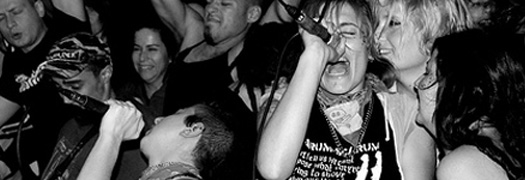
Features | Articles
Riot Grrrl and Other Things I Didn't Actually Live Through
By Lindsay Zoladz | 13 November 2010
Everyone always said that the mainstream media killed riot grrrl. It’s a familiar narrative arc in the history of underground music: a scene born out of a revolutionary aesthetic and an unconventional lifestyle acquires a name, and within the span of a few years, someone has used it in an article as an adjective describing an expensive pair of pants. Mainstream media is an easy scapegoat for this sort of thing, but it’s frustrating to accept how pervasive these descriptions become, even when you think you’re smart enough to resist them. I can say “indie,” a word that once meant a specific methodology of record distribution and a shared set of principles, and we are all right now visualizing the same pair of pants.
The story of riot grrrl takes this shape too: born out of Olympia, WA and Washington D.C., it began in the early ’90s as a youthful movement of radical feminist politics and girl-fronted punk bands like Bikini Kill, Bratmobile, and Heavens to Betsy. For a lot of girls, the shows and meetings that came out of the movement were vital outlets for voicing their marginalization and creating a more accepting and understanding punk community. Then USA Today wrote about it (“The Riot Grrrls’ punk feminist look is pure in-your-face fashion”), Seventeen wrote about it (“a lot of Riot Grrrls don’t shave and deliberately give each other bad haircuts”), and Newsweek wrote about it (“Riot Girl is feminism with a loud happy face dotting the ‘i’”), and it became misunderstood and depoliticized on such a huge, national level that no one wanted to take it seriously as anything more than a passing fashion trend. After losing their once tightly guarded control of the movement’s meaning, the key players moved on, the meetings dissolved, but the term “riot grrrl” continued to surface in diluted contexts with nagging persistence.
It’s possible that I have the world’s least cool anecdote about when I first came across the phrase “riot grrrl”: it was 1996 (about three years after the movement was considered dead by anyone who was a part of it) and I saw it printed to the left of Gwen Stefani’s mid-drift on that infamous cover of Spin that would later be dramatized in the “Don’t Speak” music video. An article I had recently read about Stefani had made a particular point of noting that she sometimes made her own pants. “Riot grrrls,” I can specifically recall thinking upon seeing that cover, “must be girls who make their own pants.”
A few years later, I was set straight when I finally heard Bikini Kill’s “New Radio,” and an obsession with all the classic riot grrrl records followed. I always felt sort of ashamed that it took me so long after the fact to figure out what the movement was really about, and I always thought that no matter how personally those records spoke to me, I was missing a vital part of riot grrrl’s message, simply because I wasn’t there when it was actually happening. But I really couldn’t be blamed. I would have loved to have gone to that first Bikini Kill show in Olympia, but I was a little busy with the whole kindergarten thing.
For those of us who weren’t there, Sara Marcus’s recently published Girls to the Front: The True Story of the Riot Grrrl Revolution does a really amazing job of breathing life into that brief moment when riot grrrl actually meant something passionate and specific. It’s such a well-told and surprisingly universal parable about a revolutionary movements that I don’t think to enjoy it you’d have to be particularly invested in feminism, but, thanks to her vivid and passionate language, you probably will be by the time you’re finished reading. For all its evocative historical reenactments of Bikini Kill shows and musings on zine culture, the most significant thing I found about Girls to the Front is that it helped me get over my faux-nostalgia—to accept the fact that I wasn’t there and to understand that that has no bearing on what this music meant to me. Towards the end of the book, Marcus describes Seanna Tully, a late-comer to the riot grrrl scene, looking jealously at the original riot grrrls who had made shrinky dink riot grrrl necklaces at some of the inaugural meetings: “‘I had first generation shrinky dink envy,’” Seanna laughed later, aware of how silly it sounded, but her comment pointed to something real: how easy it is to idealize things that happened in the past, or are happening to somebody else, as more enticing than what you could make out of your own life.”
Last week I went to a show in DC celebrating the book’s release; Marcus read from Girls to the Front in between the sets. She didn’t read the passage I quoted above, but I had it in mind all night. Most of the people there were very young, too young to have remembered riot grrrl firsthand, and as she read we sat quietly and paid hallowed respect to other people’s memories. A band called Trophy Wife, a two-piece featuring drummer Katy Otto and guitarist Diane Foglizzo, played after Marcus was finished reading. The two women face each other as they play, the tense energy of their music swarms between them and then, as if becoming too large to be contained, diffuses outward into the surrounding crowd. They are women playing creative, political, meaningful punk music, made of lives lived right now. And they sound nothing like a riot grrrl band.





